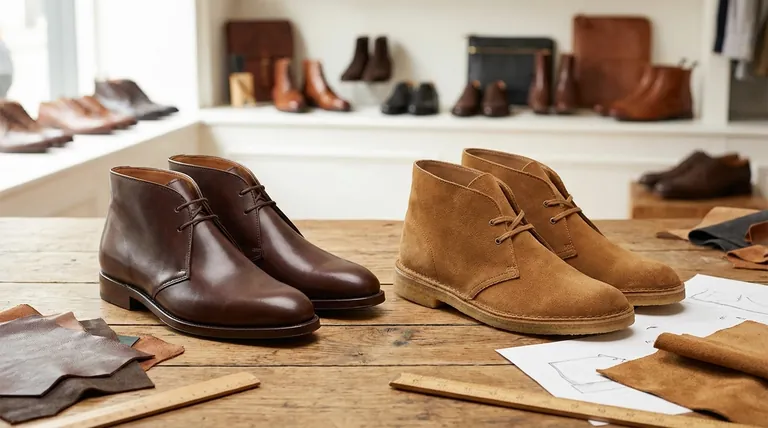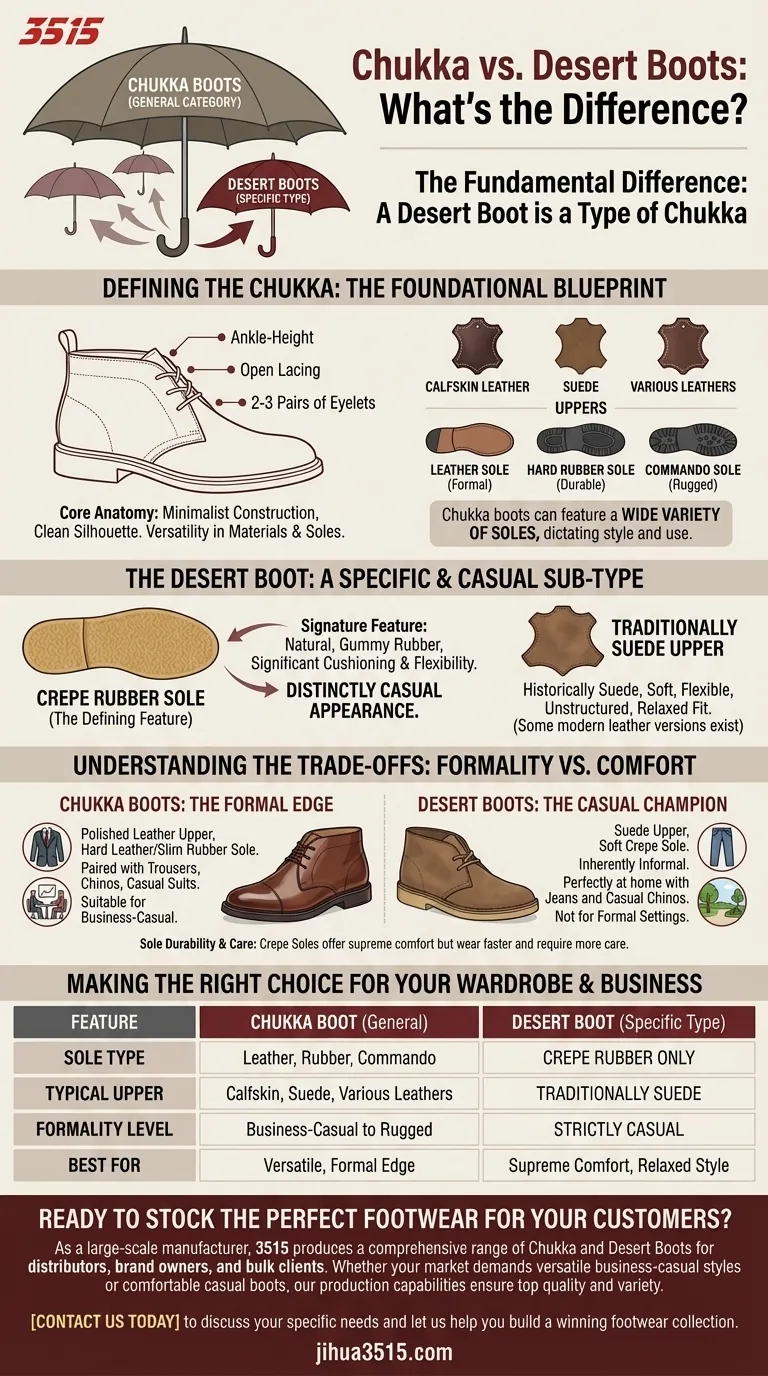The fundamental difference is simple: a desert boot is a specific type of chukka boot. While all desert boots fall under the chukka umbrella, not all chukka boots are desert boots. The key distinction lies in the sole.
A desert boot is a chukka boot defined by its signature crepe rubber sole. Chukka boots, as a broader category, can feature a wide variety of soles—from formal leather to durable rubber—which dictates their overall style and use case.

Defining the Chukka: The Foundational Blueprint
A chukka is best understood as a general design for an ankle-high boot. It serves as the basic template from which more specific styles, like the desert boot, are derived.
The Core Anatomy
A boot is classified as a chukka based on a few simple characteristics. It must be ankle-height and feature open lacing, typically with only two or three pairs of eyelets.
This minimalist construction gives the chukka its clean, uncluttered silhouette, making it a highly versatile piece of footwear.
Versatility in Materials
Chukka boots can be crafted from a wide range of materials. You will find them in everything from polished calfskin leather to casual suede. This material choice is a primary factor in determining the boot's formality.
Variety of Soles
The sole is where the chukka category shows its true breadth. A chukka can be finished with a sleek leather sole, making it suitable for business-casual attire. Alternatively, it can have a hard rubber or commando sole, giving it a more rugged, utilitarian look.
The Desert Boot: A Specific & Casual Sub-Type
The desert boot is not a different style of boot; it is a chukka with a very specific set of features that trace back to its military origins.
The Defining Feature: The Crepe Sole
The single, non-negotiable feature of a true desert boot is its plantation crepe rubber sole. This natural, gummy rubber provides significant cushioning and flexibility, making the boot exceptionally comfortable for walking.
This soft, porous sole is what gives the desert boot its distinctly casual appearance.
The Traditional Upper
Historically, desert boots are made with a suede upper. This material is soft, flexible, and often unlined, creating an unstructured and relaxed fit that molds to your foot. While some brands now offer leather versions, the classic desert boot is suede.
Understanding the Trade-offs: Formality vs. Comfort
The primary difference in construction—the sole—creates a clear trade-off between formality, comfort, and durability.
Chukka Boots: The Formal Edge
A chukka made with a polished leather upper and a hard leather or slim rubber sole is significantly more formal. It can easily be paired with trousers, chinos, and even some casual suits, bridging the gap between dress shoes and boots.
Desert Boots: The Casual Champion
The combination of a suede upper and a soft crepe sole makes the desert boot inherently informal. It is perfectly at home with jeans and casual chinos but would look out of place in a more formal or corporate setting.
Sole Durability and Care
Crepe soles offer supreme comfort but have downsides. They are softer and can wear down more quickly than hard rubber. Their porous, sticky texture also tends to attract dirt and darken over time, requiring more diligent care.
Making the Right Choice for Your Wardrobe
Your choice between a general chukka and a specific desert boot should be based entirely on your intended use.
- If your primary focus is a versatile business-casual option: Choose a chukka boot with a smooth leather upper and a hard leather or slim rubber sole.
- If your primary focus is weekend comfort and casual style: The classic suede desert boot with its crepe sole is the ideal choice.
- If you want a rugged, all-weather boot: Look for a chukka made from durable leather with a thick rubber or commando-style sole.
Ultimately, understanding the construction of the boot empowers you to choose the right tool for the job.
Summary Table:
| Feature | Chukka Boot (General) | Desert Boot (Specific Type) |
|---|---|---|
| Sole Type | Leather, rubber, commando | Crepe rubber only |
| Typical Upper | Calfskin, suede, various leathers | Traditionally suede |
| Formality Level | Business-casual to rugged | Strictly casual |
| Best For | Versatile, formal edge | Supreme comfort, relaxed style |
Ready to Stock the Perfect Footwear for Your Customers?
As a large-scale manufacturer, 3515 produces a comprehensive range of chukka and desert boots for distributors, brand owners, and bulk clients. Whether your market demands versatile business-casual styles or comfortable casual boots, our production capabilities ensure top quality and variety.
Contact us today to discuss your specific needs and let us help you build a winning footwear collection.
Visual Guide

Related Products
- Durable Leather High-Ankle Tactical Boots for Wholesale & Custom Manufacturing
- Wholesale Lightweight Tactical Boots Custom Manufacturer for Desert & Combat Use
- Premium Wholesale Waterproof Safety Boots High Performance Protection for Industrial Markets
- Durable High-Ankle Tactical Boots Wholesale Manufacturer for Custom & Bulk Orders
- Wholesale Classic Leather Lace-Up Ankle Boots for Brand Manufacturing
People Also Ask
- What is the function of the insole in tactical boots? A Guide to Foot Support & Performance
- What additional comfort features should be considered in tactical boots? Enhance Endurance and Performance
- How do tactical boots differ from regular footwear? A Guide to Purpose-Built Performance
- What does the upper part of a tactical boot cover? Your Guide to Protection, Fit, and Performance
- What features distinguish a tactical boot from regular boots? Uncover the Key Design Differences



















